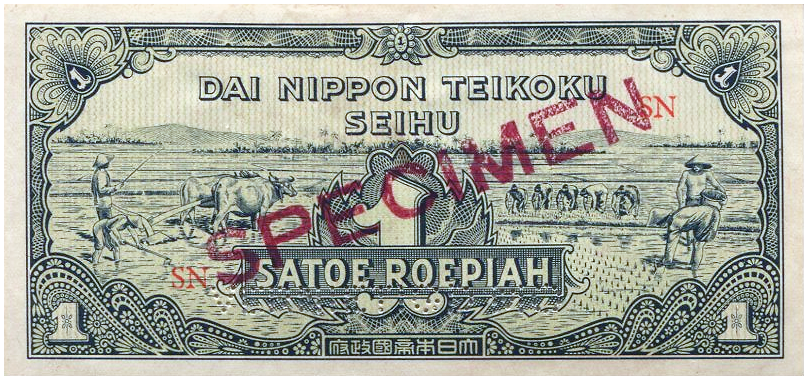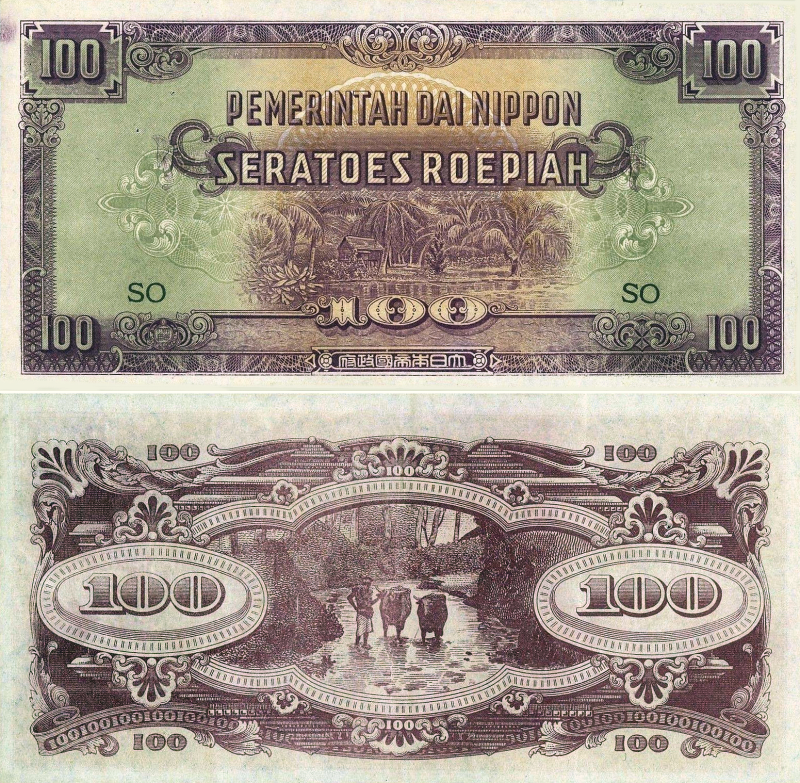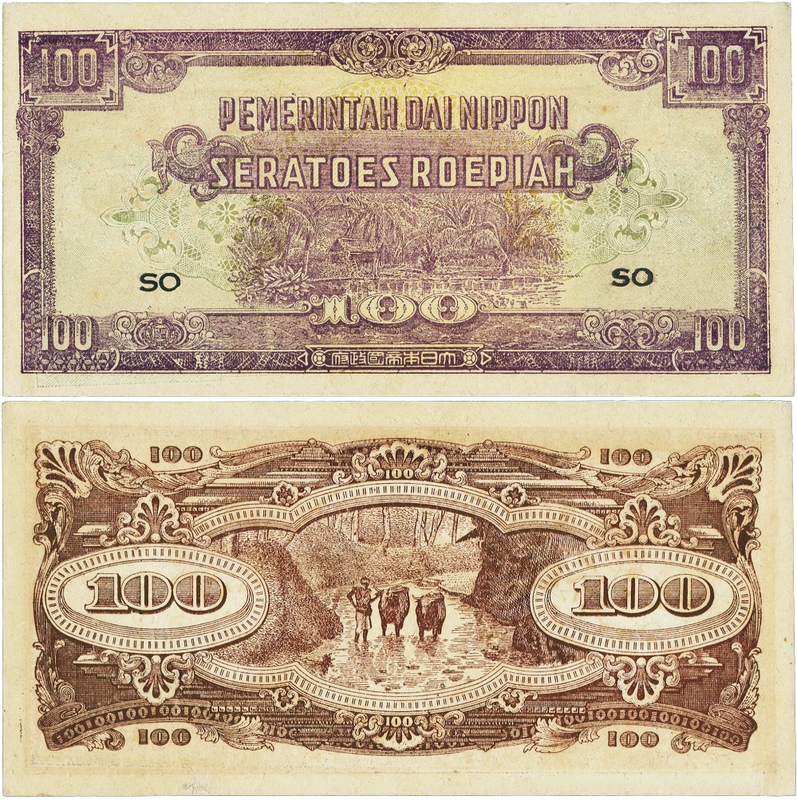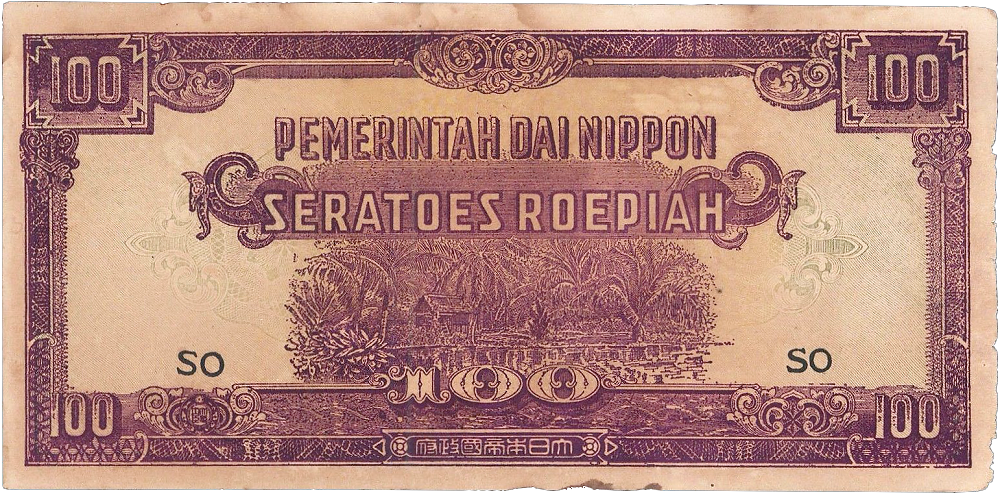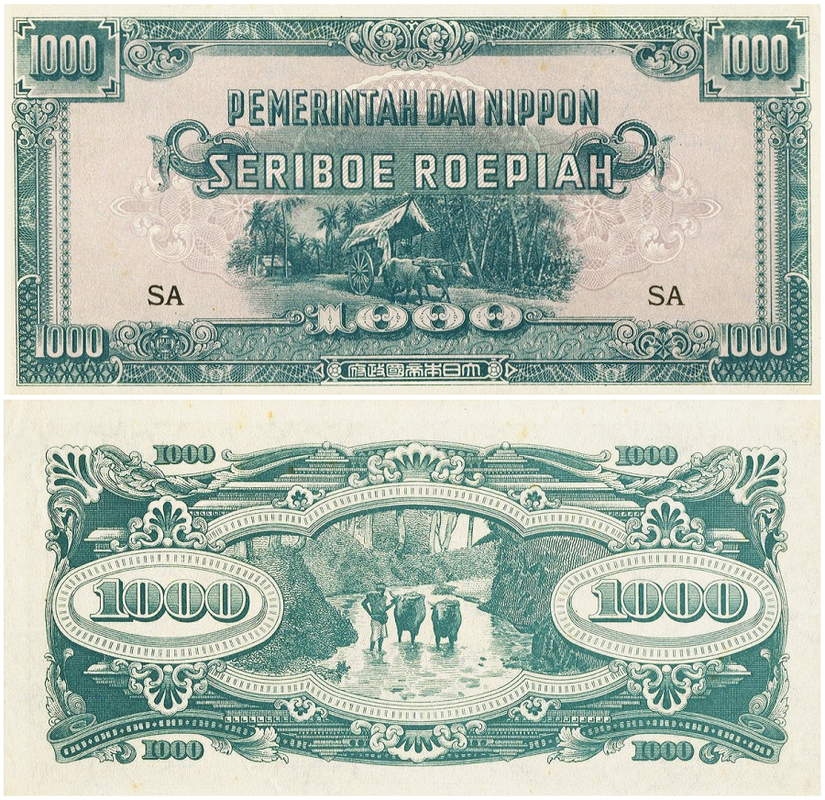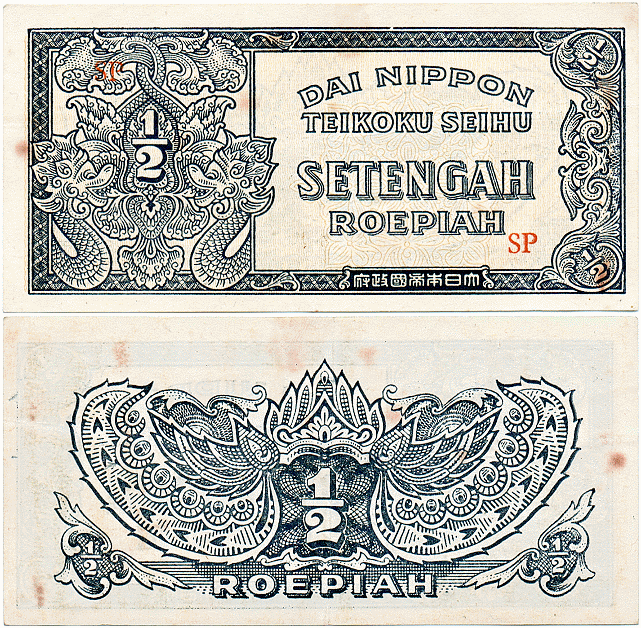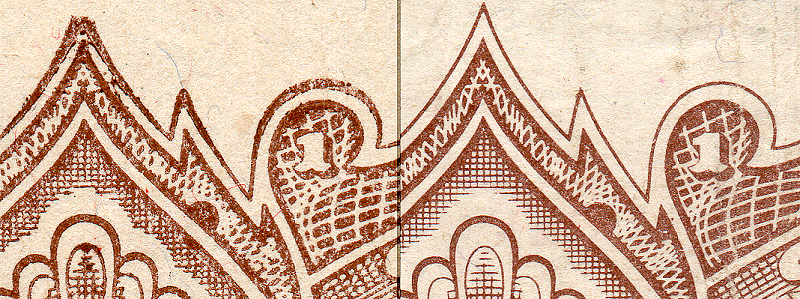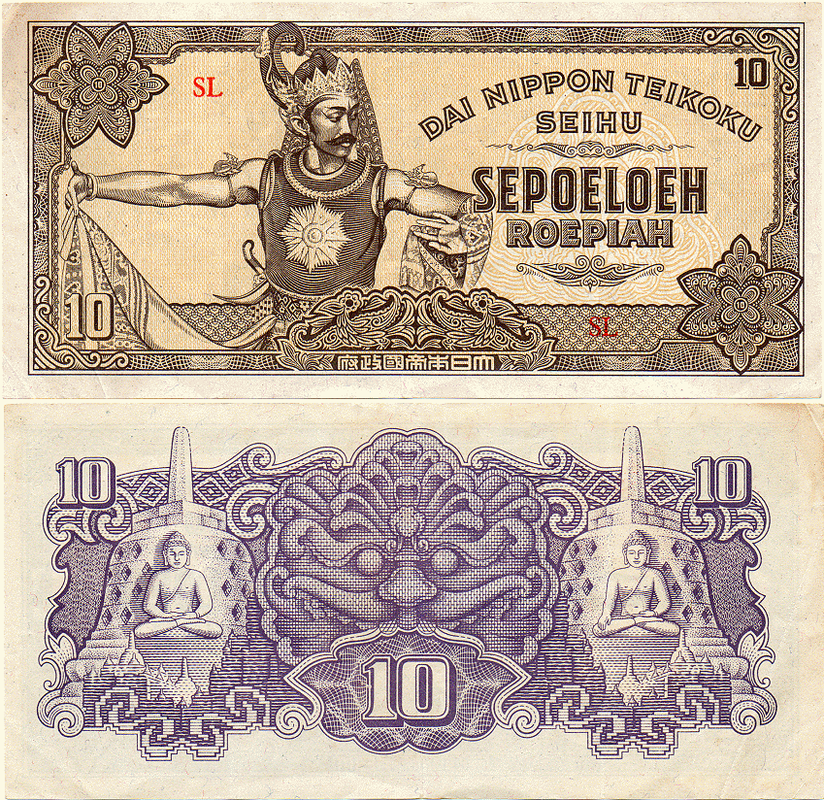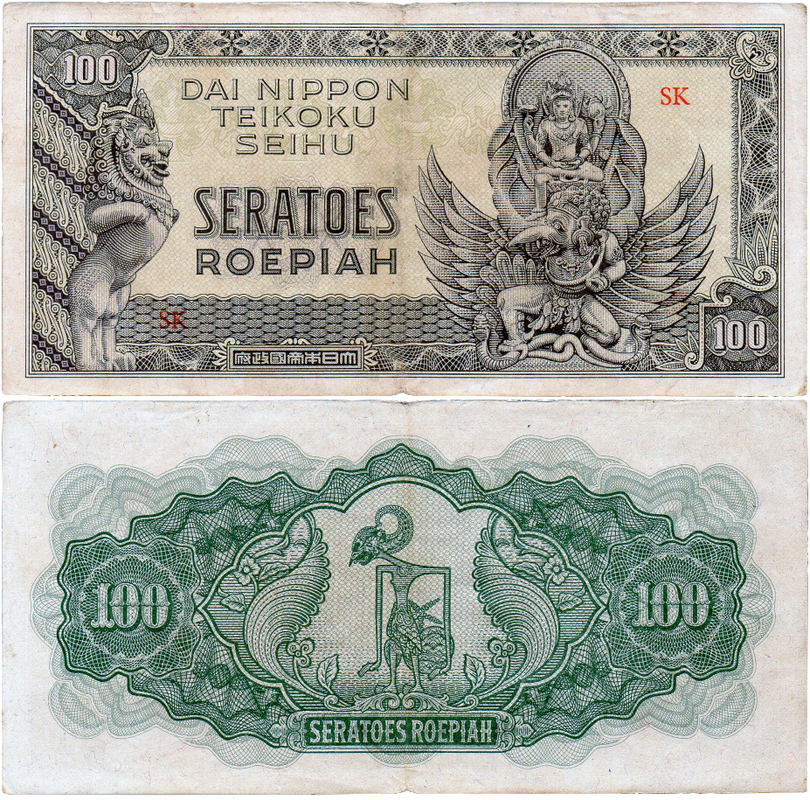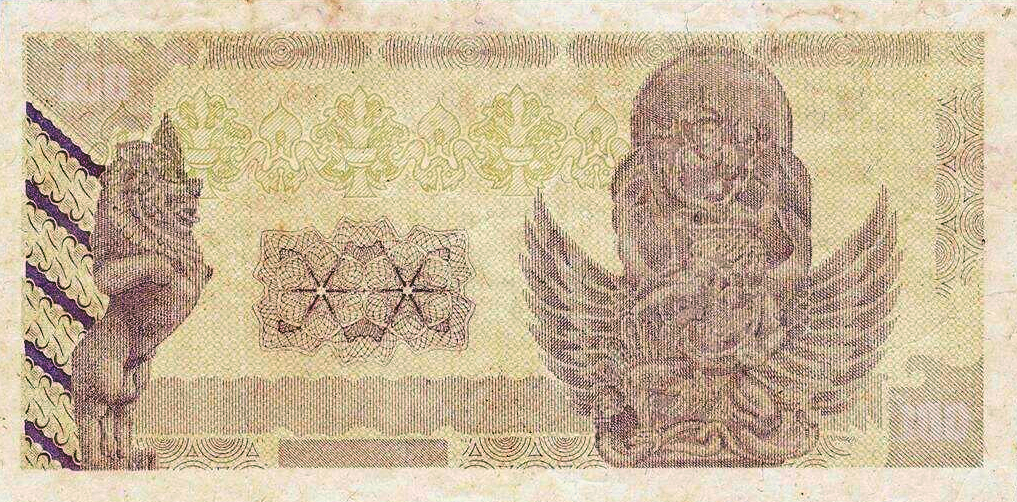The Japanese Occupation of the 'S' Netherlands Indies
|
Updated September 17 2016
|
PEMERINTAH DAI NIPPON - The Japanese Government
'1944'
This short lived series of two denominations (one of which was never issued), saw the change of the issuer title and currency name from the Dutch language and currency, to Indonesian.
|
100 Roepiah - Seratoes Roepiah Undated. Similar to the 1944 Malaya 100 Dollars. Brown-violet on green. (front) jungle scene with hut. (back) farmer leading pair of oxen along river bed. Watermark: quatrefoil kiri flower (only on type 1) Printer: Djakarta Insatsu Kodjo Type 1 (SCWPM 126a) Block serial: SO. Engraved front. Watermarked. Scarce (right). Type 2 (SCWPM 126b) Block serial: SO. Lithographed front, with silk threads. Block letters 'sans serif' style. Many forgeries are reported. Type 3 (SCWPM 126c) Block serial: SO. Lithographed front, with silk threads. Block letters not 'sans serif'. Type 4 (SCWPM 126r) Remainder without block serial. Type 5 Specimen Type 6 Allied forgery (suspected). Right: it is unclear whether this example is an 'Allied' counterfeit or a more local forgery, or for that matter simply one of the two reported lithographed versions of this note? Right: another forgery, or again, even a version of the issued note?
|
|
1000 Roepiah - Seriboe Roepiah
Undated. Similar to the 1944 Malaya 1000 Dollars. Blue-green on purple. (front) pair of oxen pulling cart. (back) farmer leading pair of oxen along river bed. Watermark: quatrefoil kiri flower Printer: Djakarta Insatsu Kodjo Type 1 (SCWPM 127a) Block serial: SA. Engraved front. Watermarked. Some examples show a deeper coloured underprint. Rare (right). There may be a lithographed version. Type 2 Specimen |
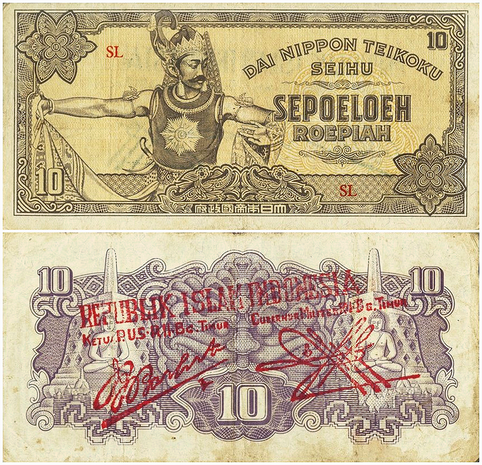
DAI NIPPON TEIKOKU SEIHU “Nanpo Kaihatsu Ginko”
The Southern Development Bank Issues 1944-1945
This series of notes bares the text in anglicised Japanese and Indonesian, and refers specifically to the 'Great Japanese Empire' (Dai Nippon Teikoku) rather than the slightly more subtle Japanese Government (or, De Japansche Regeering) used on earlier issues of Japanese Occupation Money. The notes of this series also no longer bare the small circular seal of the Japanese Ministry of Finance. Playing upon nationalistic sympathies, the denomination has been changed to the more nationalistic 'roepiah', replacing the gulden of Dutch colonial rule.
Right: These notes continued to circulate after the war, until 1949. From 1950 to 1965 they were used on Celebes by the "Republik Islam Indonesia" independence movement; over-stamped with the text “Ketua Pemerintah Umum Sementara, Republik Indonesia, Bagian Timur” (Chairman of the interim government of the Islamic Republic Indonesia, East Indonesia region).
The imagery depicted upon this currency
Wayang is Indonesian shadow puppet theatre, with Orang indicating a performance of real people playing the roles and replicating the puppet movements. The figure on the front of the 10 roepiah (below) is depicted in the role of Gatotkaca - a character in the Hindu epic Mahabharata - known as the son of Bimasena, and was said to have extraordinary powers.
Borobudur, the vast 9th-century Mahayana Buddhist monument near Magelang, Central Java. The largest Buddhist monument on Earth, Borobudur was in use until the 14th century, abandoned and nearly forgotten until re-discovered beneath a layer of jungle in the 19th century. It is now both a major Buddhist pilgrimage site and tourist attraction with UNESCO World Heritage status.
Inflation:
"In Sumatra, one officer recalled that a month’s salary wouldn’t even buy a bowl of ramen ( a kind of Japanese noodles), which means that it cost 100 yen or more." Whether this was actual Japanese Yen or it's local supposed equivalent (the occupation currency listed here) is unclear.
(Reference: Hideo Kobayashi, Nihon gunsei-ka no ajia [“Asia under Japan`s military rule” ] Publ. Iwanami-shinsho, Shogenshu: Nihongun senryoka no Indoneshia [“Collection of Testimony: Indonesia Under Japanese Occupation”])
The block serials
The block serials indicate that only one series of each denomination was planned (albeit without any specified limit to issue) and that the second letter of the block is no longer referring to a series of issue as with earlier 'Japanese Government' notes, but now to the denomination. The series runs in reverse alphabetical order from: SK (100 Roepiah), SL (10 Roepiah), SM (5 Roepiah), SN (1 Roepiah, (SO, omitted as assigned to the earlier 100 Roepiah 'Pemerintah Dai Nippon'), and SP, (1/2 Roepiah).
The Money:
|
1/2 Roepiah - Setengah Roepiah
Undated. Grey-black on tan. (front) stylised dragons flanking amount at left. (back) amount at centre with stylised crown above and flanked by wing-like projections. Printer: Djakarta Insatsu Kodjo (Kolff) Type 1 (SCWPM 128a) Block serial: SP. Lithographed. (right). Type 2 Specimen |
|
1 Roepiah - Satoe Roepiah
Undated. Grey-black on green. (front) Labourers at work rice growing. (back) a Banyan tree and the temples of Dieng Plateau. Printer: Djakarta Insatsu Kodjo (Kolff) Type 1 (SCWPM 129a) Block serial: SN. Lithographed. (right). Type 2 possible forgery - block serial: SN. Lithographed. (below right). A larger front and back plate, a larger note. Heavier block serial. The back plate is poorer quality, with much thicker lines and stubbed pinnacles. Possibly by a different printer - or a period forgery? Below: (fig1) comparative close-ups of the suspected forgery (left) and a standard issue note (right). Fig1 Left: forgery Right: genuine
Type 3 Specimen
|
|
5 Roepiah - Lima Roepiah
Undated. Green on light green. (front) Pa Mbelgah's house, a Large Karo style Batak house in Kabanjahe village, Northern Sumatra. (back) Toba style Batak house at left with Batak woman in headdress at centre. Printer: Djakarta Insatsu Kodjo (Kolff) Type 1 (SCWPM 130a) Block serial: SM. Lithographed. (right). Type 2 Specimen |
|
10 Roepiah - Sepoeloeh Roepiah
Undated. Brown on yellow. (front) Indonesian Wayang Orang dancer. (A thematic revival of the 1930s Dutch colonial issues for the region). (back) a Buddha statue with it's normally encapsulating pierced stupa as found at the upper platform of Borobudur, the vast 9th-century Mahayana Buddhist monument near Magelang, Central Java. Printer: Djakarta Insatsu Kodjo (Kolff) Type 1 (SCWPM 131a) Block serial: SL. Lithographed. (right). Type 2 (SCWPM 131b) Proof with light blue underprint. Type 3 Specimen |
|
100 Roepiah - Seratoes Roepiah
Undated. Brown on light green. (front) lion sculpture at left, Garuda and goddess sculpture at right. (back) Wayang Kulit puppet at centre; of Arjuna, the only undefeated hero in the Hindu epic - the Mahabharata. Printer: Djakarta Insatsu Kodjo (Kolff) Type 1 (SCWPM 132a) Block serial: SK. Lithographed. (right). Type 2 Specimen Right: a trial printing specimen of the underprint of the 100 Roepiah
|
